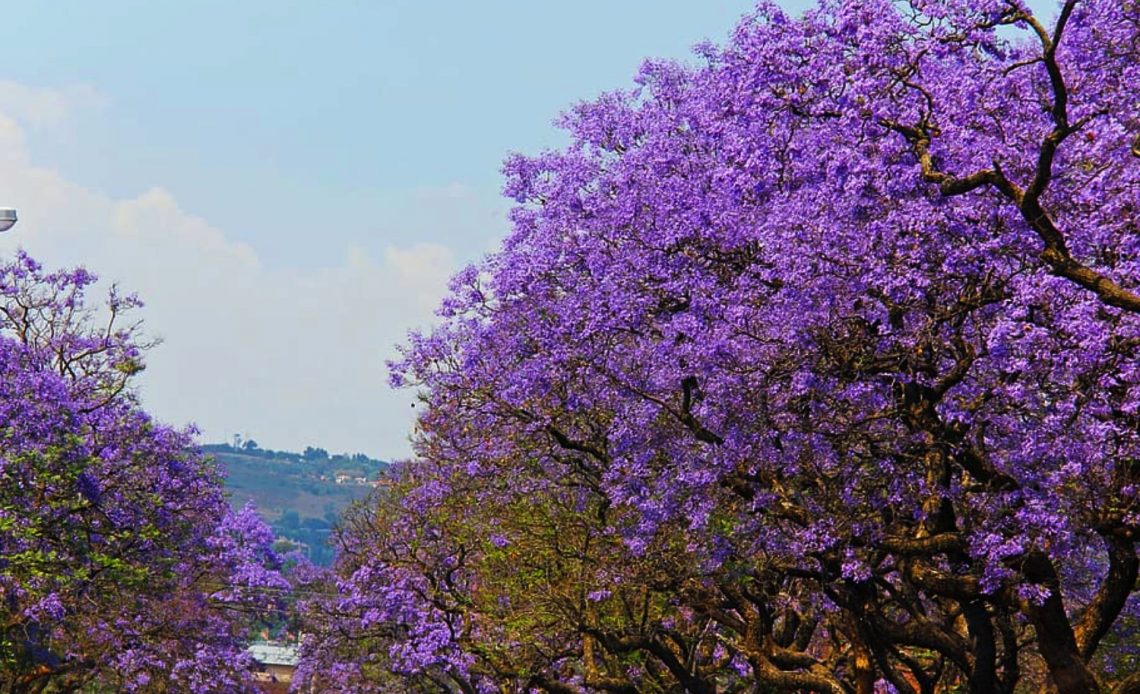

We’re here to help! Wild Yards is a completely free website that is 100% dedicated to helping you create a wildlife-friendly, sustainable yard. Read more
WildYards is reader-supported. When you buy a product through a link on our site, we may earn a comission. Every product is independently selected by our (obsessive) editors and our reviews are unbiased and objective. Read more about our mission or our privacy policy.
Want to dress up that boring corner of your yard? Why not fill the space with a new tree?
There are so many great reasons to plant a tree.
They provide shelter to birds, squirrels, and other wildlife, for one thing. And, for another, they help offset our carbon load by producing more oxygen.
From privacy trees like Austree hybrids to shade trees like Autumn Blaze red maples, there are so many trees to love.
But if you want a plant a tree that really makes a statement, purple flowering trees will help you transform your yard into a real showstopper.
Fragrant lilacs, vitex, and Takasago flowering cherry trees produce beautiful purple flowers that will help you attract pollinators. Meanwhile, crape myrtles, desert willows, and eastern redbuds are excellent options for low-maintenance landscapes.
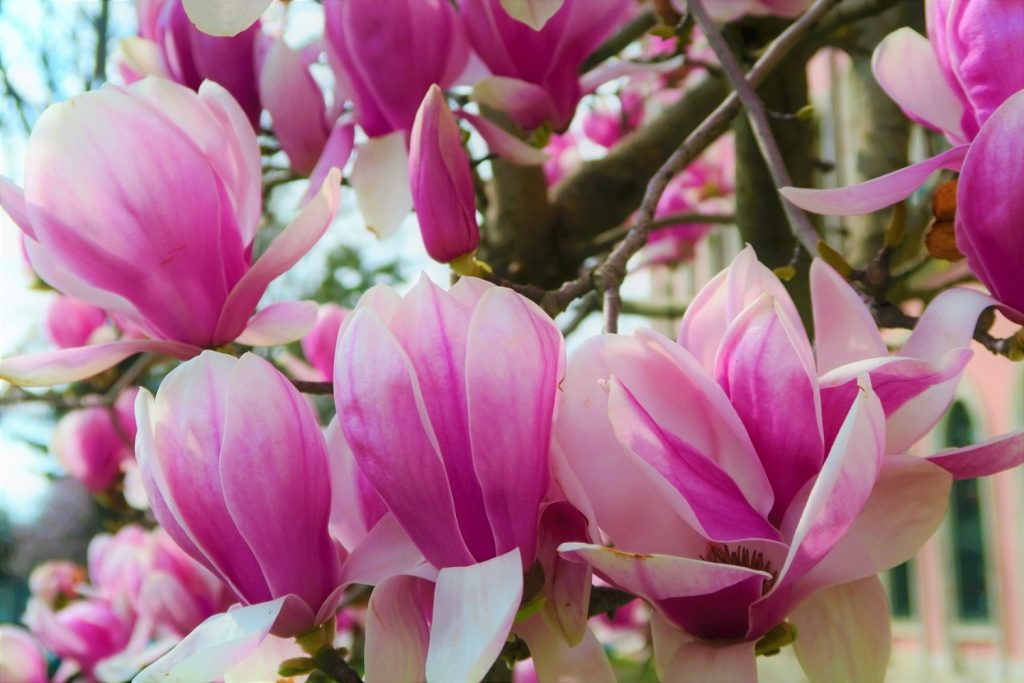
Royal Empress
| Species | Paulownia tomentosa |
| Growing zones | 5 through 10 |
| Light requirements | Full sun |
| Soil preference | Sandy, loamy, clay. Prefers well-draining soils rich in organic matter. |
| Growth rate | Fast |
| Maximum size | 30’ to 60’ tall by 30’ to 40’ wide |
Also known as the princess tree or royal paulownia, the royal empress tree is beloved for its fast growth rate and huge clusters of fragrant purple flowers.
This tree is an excellent choice for sunny yards that could use a bit more shade. However, it’s worth mentioning that these trees are considered to be invasive in warmer parts of the United States.
The royal empress tree is highly adaptable and can be found growing in nutrient-poor sandy and clay-rich soils.
That said, these trees will grow fastest when planted in soils that contain a moderate amount of organic materials.
When these trees bloom in late spring to early summer, they produce scads of beautiful purple flowers that are especially attractive to bumblebees.
They also have poor tolerance for wind, so be sure to plant your royal empress tree in a sheltered corner of your backyard.
Texas Mountain Laurel
| Species | Dermatophyllum secundiflorum, previously Sophora secundiflora |
| Growing zones | 7 through 10 |
| Light requirements | Full sun |
| Soil preference | Sandy, loamy, rocky. Requires excellent drainage |
| Growth rate | Slow to moderate |
| Maximum size | 10’ to 15’ tall by 6’ to 10’ wide |
An evergreen shrub native to Mexico, the Texas mountain laurel’s compact size makes it a suitable purple flowering tree for small spots in your landscaping.
The Texas mountain laurel isn’t picky about its soil. This tree will perform just as well in nutrient-deficient soils as it will in nutritious ones.
In late winter to early spring, these trees produce clusters of purple flowers similar to wisteria.
Once pollinated by bees, beetles, and butterflies, the flowers give way to seed pods, which stand in stark contrast to the plant’s leathery brown foliage.
The Texas mountain laurel is capable of surviving extreme heat. Plants are drought-tolerant once established, making them great trees for low-maintenance landscapes.
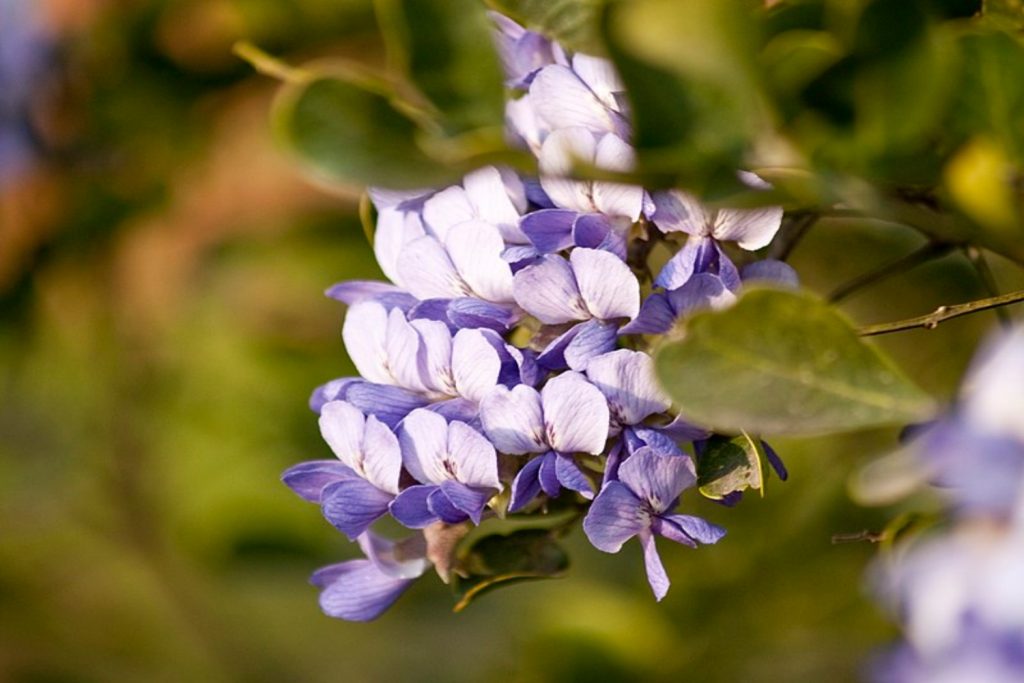
Eastern Redbud
| Species | Cercis canadensis |
| Growing zones | 4 through 9 |
| Light requirements | Full sun to partial shade |
| Soil preference | Sandy, loamy, clay. Needs well-draining soil |
| Growth rate | Moderate to fast |
| Maximum size | 20’ to 30’ tall by 35’ to 40’ wide |
Delicate in appearance and with gorgeous heart-shaped leaves, the eastern redbud doesn’t require much care.
These plants perform best when planted in well-draining soil. Although they should be kept moist after transplanting, these trees are quite drought-resistant once established.
The eastern redbud produces clusters of tiny red-pink to purple blossoms in late winter and early spring.
The flowers have a mild but sweet fragrance that makes them popular with all sorts of pollinators, from moths to hummingbirds.
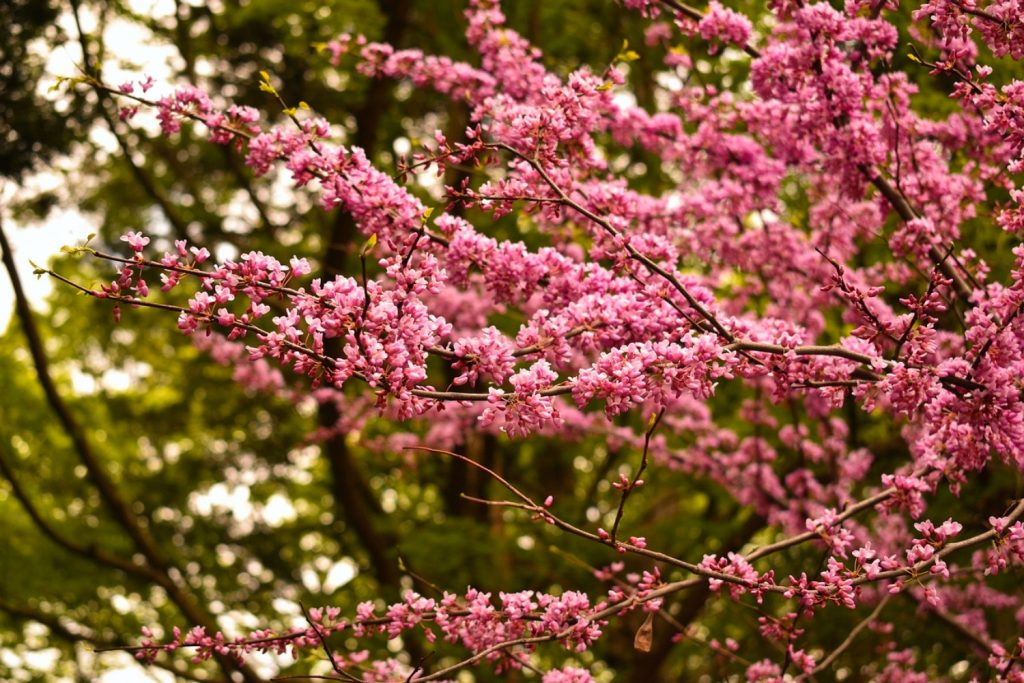
Fragrant Lilac
| Species | Syringa vulgaris |
| Growing zones | 3 through 7 |
| Light requirements | Full sun |
| Soil preference | Sandy, loamy, clay. Prefers soil rich in organic matter. Needs good drainage |
| Growth rate | Moderate |
| Maximum size | 8’ to 15’ tall by 6’ to 12’ wide |
When they say fragrant, they mean it! When the fragrant lilac blooms in spring, the delicious perfume the flowers creates attracts tons of pollinators to your garden.
Plant this purple flowering tree if you want to attract the attention of your local butterflies and honeybees.
The fragrant lilac, also known as the common lilac or the French lilac, produces lovely purple flowers that work well in cottage-inspired landscapes.
These trees grow at a moderate pace and are adaptable to a wide range of soil types. Just ensure that your fragrant lilac is growing in well-draining soil and it will perform well.
The fragrant lilac’s modest size makes it an excellent choice of accent plant for flower beds.
Grow your fragrant lilac in full sun to provide some shade for the flowers and shrubs on the ground below.
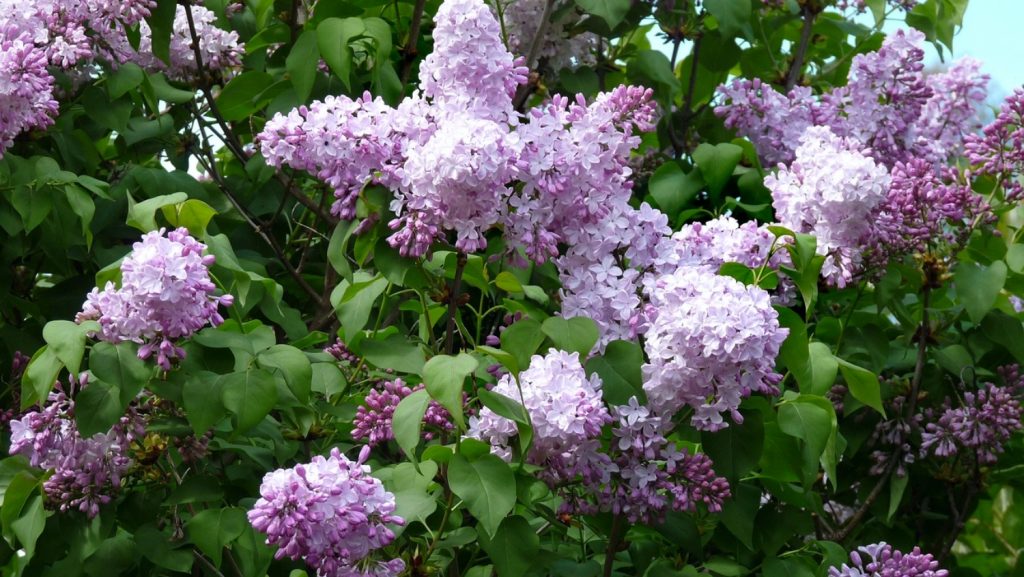
Vitex
| Species | Vitex agnus-castus |
| Growing zones | 6 through 9 |
| Light requirements | Full sun |
| Soil preference | Sandy, loamy, clay. Prefers fertile soils that drain well |
| Growth rate | Moderate to fast |
| Maximum size | 10’ to 20’ tall by 10’ to 15’ wide |
If you want a beautiful flowering tree for your yard, but you’re not sure what to grow because it stays sunny and hot, then the vitex is the tree for you.
Also known as chasteberry or monk’s pepper, the vitex tree produces dense, shrubby undergrowth, the perfect hiding place for songbirds.
Plants bloom from spring to summer, producing fragrant true purple flowers (although some vitex produce flowers in shades of pink and blue).
Once your vitex starts flowering, don’t get too close. You can practically hear the shrub humming with all of the bees busy pollinating its flowers!
Vitex trees grow well, in spite of intense heat. Plants are drought-tolerant once established.
Prune plants after flowering to give them a manicured appearance. Encouraging more of a tree-like shape enables the vitex to provide shade to surrounding plants.
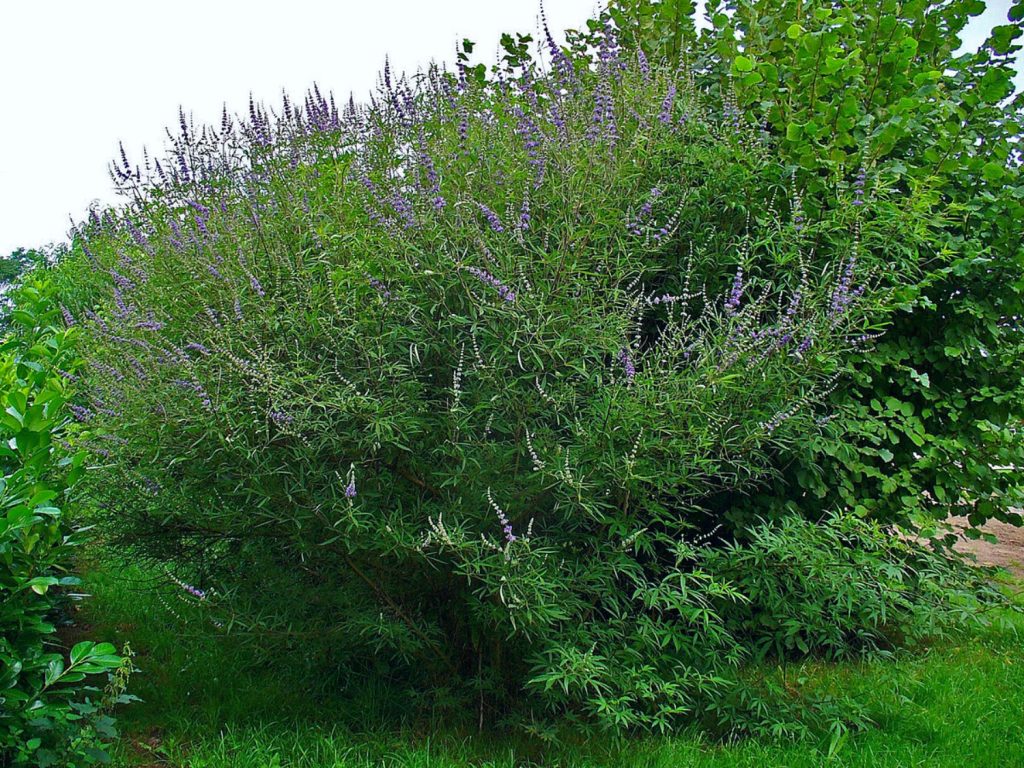
Desert Willow
| Species | Chilopsis linearis |
| Growing zones | 7 through 11 |
| Light requirements | Full sun |
| Soil preference | Sandy to loamy. Prefers well-draining soils |
| Growth rate | Moderate to fast |
| Maximum size | 15’ to 40’ tall by 10’ to 20’ wide |
Perfect for southwest-inspired landscapes, the desert willow is a shrub tree with a sprawling growth habit, lance-shaped leaves, and delicate bell-shaped purple flowers.
As its name might lead you to suspect, the desert willow has low water needs. Like the vitex tree, desert willow absolutely thrives in full sun and hot temperatures.
These plants grow effortlessly in well-draining soils and can survive long periods without water once they’ve matured.
The desert willow is not tolerant of high humidity. These trees need good air circulation. Be sure to plant your desert willow in a well-ventilated area.
These trees bloom in midsummer, dressing up your backyard with pink to purple flowers.
Plant desert willow with fast-growing cacti like Peruvian apple cactus and prickly pear for an authentic desert garden.
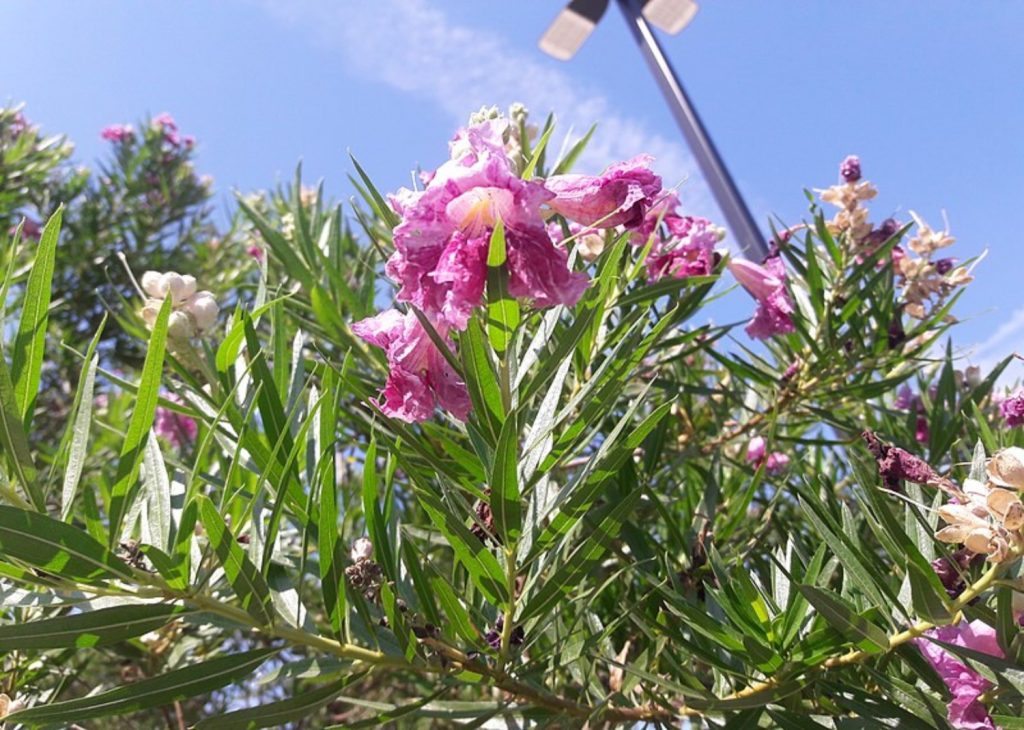
Jacaranda
| Species | Jacaranda mimosifolia |
| Growing zones | 9 through 11 |
| Light requirements | Full sun |
| Soil preference | Sandy, loamy, clay. Must have well-draining soil |
| Growth rate | Fast |
| Maximum size | 25’ to 50’ tall by 15’ to 30’ wide |
This purple flowering tree is an excellent choice if you want to fill a large gap in your landscaping fast.
Because the jacaranda grows so big, it also works well as a shade tree.
The plant’s frond-like leaves resemble those of the mimosa tree and offer shade and shelter to local songbirds.
When trees bloom in late summer, their entire canopy is transformed into an umbrella of blue-purple blossoms.
The jacaranda tree’s flowers are popular with beneficial insects. Not just pollinators, like bees, but also hoverflies and predatory wasps which help keep pest levels down in the rest of your garden.
Although some gardeners consider the jacaranda to be an invasive weed, the plant’s hardy and fast-growing nature makes it a viable option for homeowners with less-than-ideal growing conditions.
Crape Myrtle
| Species | Lagerstroemia |
| Growing zones | 7 through 9 |
| Light requirements | Full sun |
| Soil preference | Sandy, loamy, clay. Prefers soils that are rich in organic materials and drain well |
| Growth rate | Moderate to fast |
| Maximum size | 10’ to 30’ tall by 10 to 25’ wide |
Crape myrtles are incredibly popular in the south, thanks to their ability to withstand heat, dry spells, and even occasional flooding.
Plants flower from late to midsummer, producing distinctive flower clusters with petals that resemble tissue paper.
Although crape myrtles come in shades of pink, red, and white, purple crape myrtles are available, too, and can help attract hummingbirds and other pollinators to your yard.
The crape myrtle has a bushy growth habit, producing dense foliage from the ground up. However, these compact trees can be trimmed to reveal their pale tan paper-thin bark.
To accelerate your crape myrtle’s growth rate, enrich your native soil with compost. This will nourish the plant and add structure to the soil to improve drainage.
Horticultural sand can be used to amend overly-compacted soils to make the substrate more suitable for crape myrtles, if necessary.
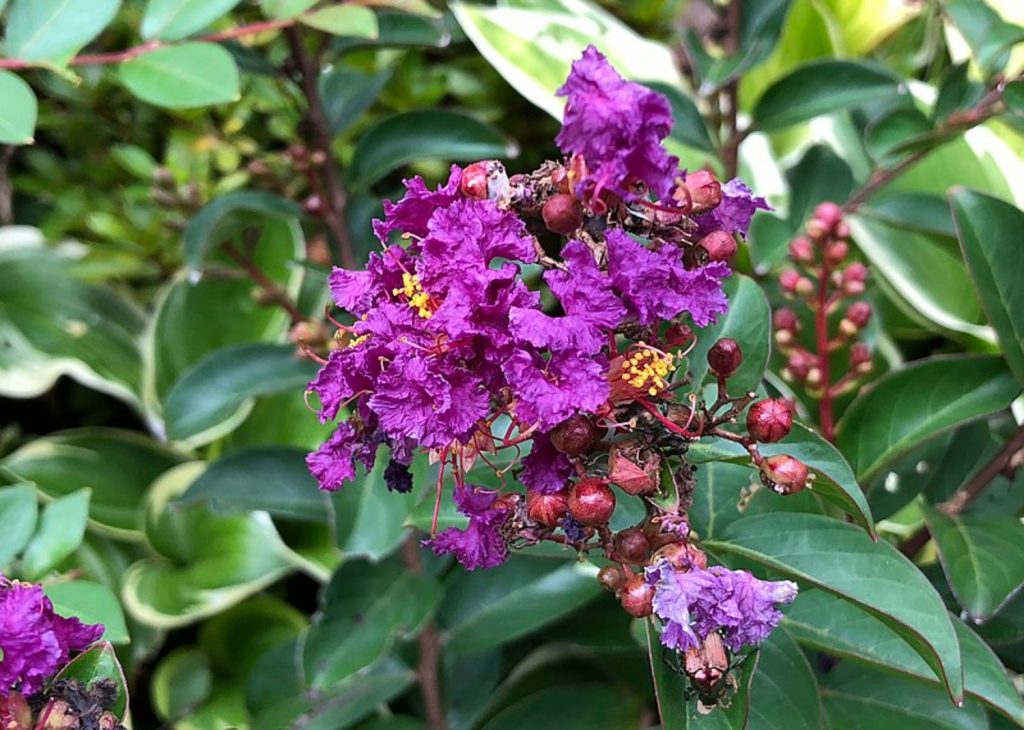
Takasago Flowering Cherry
| Species | Prunus ‘Takasago’ |
| Growing zones | 5through 8 |
| Light requirements | Full sun to partial shade |
| Soil preference | Sandy, loamy, clay. Well draining |
| Growth rate | Moderate to fast |
| Maximum size | 15’ to 25’ tall by 15’ to 20’ wide |
If you want to add a splash of purple to your Japanese-inspired zen garden, then the Takasago flowering cherry tree is the one for you.
In early spring, the trees are covered in tiny white blossoms that are shaded with a blush of pink and purple.
Compared to the brilliant splash of purple that trees like the royal empress, jacaranda, and vitex produce, the Takasago flowering cherry is much more subtle.
Timeless and elegant, the Takasago flowering cherry tree is suitable for a broad range of landscape styles, from dramatic to farmhouse and everywhere in between.
Use the Takasago flowering cherry to draw more pollinators to your backyard.
Plant this purple flowering tree alongside azaleas, hydrangeas, and elephant ears to give your foundation landscaping a classic feel.
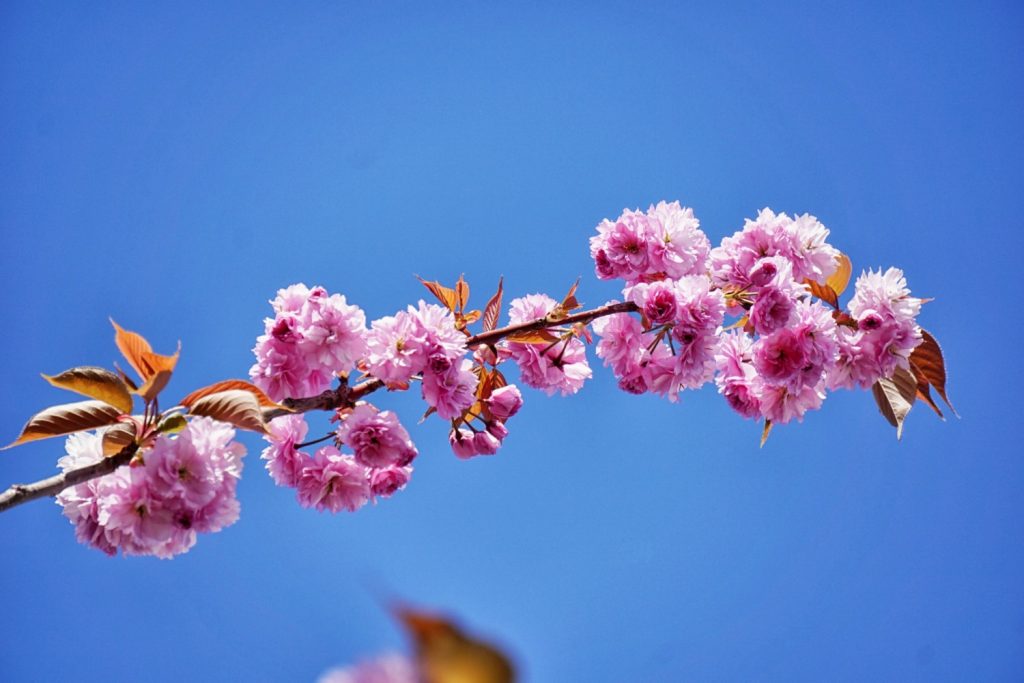
Purple Robe Locust
| Species | Robinia pseudoacacia |
| Growing zones | 4 through 9 |
| Light requirements | Full sun to partial shade |
| Soil preference | Sandy, loamy, rocky, poor. Prefers good drainage |
| Growth rate | Fast |
| Maximum size | 30’ to 70’ tall by 20’ to 40’ wide |
In spring, the purple robe locust produces deep red-purple clusters of flowers, reminiscent of wisteria but not quite as delicate.
Naturally, the fragrant blossoms are a hit with pollinators, especially butterflies, moths, and bees.
These trees have a fast growth rate, quickly filling in the gaps in your landscaping.
Consider growing a row of purple robe locust trees to create a border along your fence line.
The purple robe locust is a showstopper, and its large size makes it the perfect focal point for your space.
Purple robe locusts are strong and sturdy, resistant to pests, diseases, deer, and droughts. They can also stand up to storm damage.
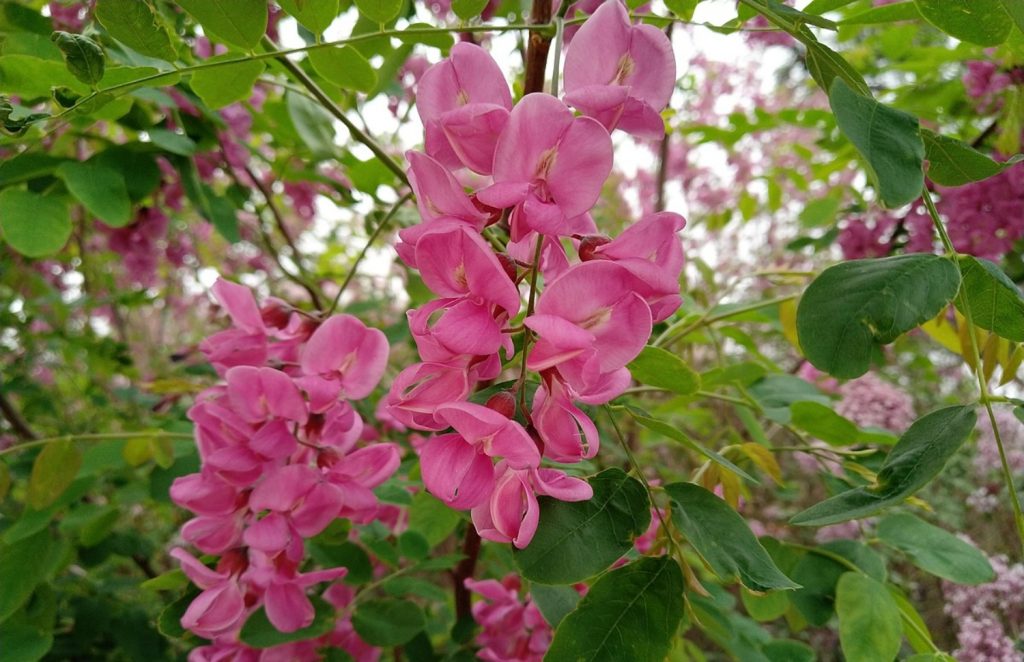
Jane Magnolia
| Species | Magnolia ‘Jane’ |
| Growing zones | 4 through 8 |
| Light requirements | Full sun to partial shade |
| Soil preference | Sandy, loamy, clay. Needs well-draining soil |
| Growth rate | Moderate |
| Maximum size | 10’ to 15’ tall by 8’ to 10’ wide |
The Jane magnolia is the perfect purple flowering tree for landscaped beds and small spaces.
This lovely tree blooms from 2 to 4 weeks in the spring, when its branches are covered in red-purple flowers that look like teacups sitting in saucers.
The Jane magnolia is a member of the “little girl” magnolia hybrid series, developed in the 1950s.
This tree’s compact growth habit makes it a safe haven for birds and squirrels, who enjoy nesting in the tree’s wide-spreading branches.
Grow a single Jane magnolia as an accent plant. Or, grow them together to create a dense border of leathery green foliage, which is characteristic of all members of the magnolia family.
Tips for choosing the right purple flowering tree for your yard
There are two things you need to keep in mind when choosing the right tree for your backyard.
First, determine how much space you have to work with. Compact shrub trees like crape myrtles and Jane magnolias are naturally better suited to small gardens than big trees like jacarandas.
Second, consider your garden’s growing conditions. Trees like desert willows suffer when grown in partial shade, but Takasago flowering cherry trees can handle lower light conditions.
By choosing the right tree for your yard, you can create the perfect focal point and fill your landscape with beautiful purple flowers.
